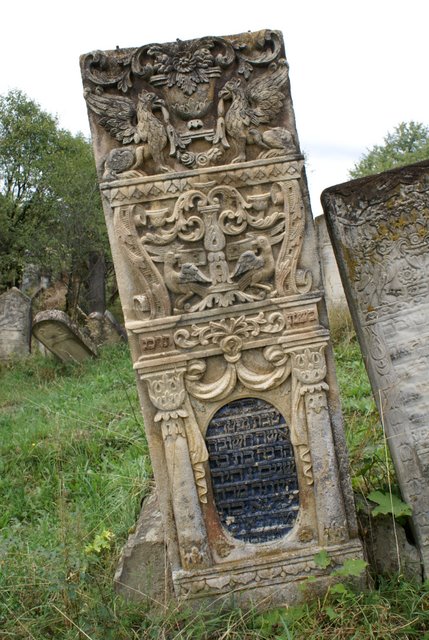Here's a cross post of my latest entry on the (Candle)sticksonstone web site
More thoughts on candlestick typology
The basis of this project is the collection of photographs of candlesticks on Jewish tombstones that I myself have taken, in Romania, Ukraine, Poland and elsewhere. These images show a vast range of artistry, skill and invention in the portrayal of the candlestick motif in denoting Jewish women. But they are by no means exhaustive. And, in fact, the more I read and the more I work here at the Hadassah Brandeis Institute thinking and theorizing, the more I simply want to be back in the field, seeking out the stones and documenting the iconography, particularly forms that I failed to photographs on earlier trips.
There is, actually, not very much published material on East European tombstone decoration, and even less about the candles/candlestick/menorah motif used to denote women’s tombs. Scholars have begun to bemoan this. There is, wrote University of Massachusetts professor Aviva Ben Ur, “an academic print culture that regards sculpted stones and cemeteries as largely peripheral [...] The historian’s focus on the written word has also meant that stone imagery is at most a secondary consideration. Research on Jewish sepulchres has thus focused on inscriptions, and has been primarily concerned with local community history, genealogy of distinguished members, and linguistic aspects.” (See her article “Still Life: Sephardi, Ashkenazi, and West African Art and Form in Suriname’s Jewish Cemeteries” in American Jewish History, vol 92/1).
This attitude was borne out by the distinguished art historian Moshe Barasch, who in 1988 wrote a memoir article, “Reflection on Tombstones: Childhood Memories,” about the Jewish cemetery in his native Czernowitz (now Cernivtsi) Ukraine. Concerning the “level of artistic achievement” of the stone-carvings, he wrote:
Not too much should be expected. I shall have to describe the artistic character of the monuments as “primitive,” without going into a discussion of what the term means, fully aware that the meaning is far from obvious [...] Keeping mind the rather modest quality of these monuments, one’s expectations as to what the free exercise of an artist’s skill may provide in them should not be too high. (article published in Artibus et Historiae, Vol. 9, No. 17 (1988), pp. 127-135)I of course strongly disagree with Barasch! (And the pictures that go with his article also prove him wrong.) He does admit, though, that one can be “often surprised” by “the variations invented by popular fantasy and executed by anonymous stone carvers.”
In his PhD dissertation (which he very kindly sent me) Boris Khaimovich, of the Center for Jewish Art in Jerusalem, writes deeply and exhaustively about the carving, form and iconography of Jewish tombstones in western Ukraine in the 17th and 18th centuries — a period where some women’s tombstones were marked by candles but before the “boom” in this imagery in the 19th century that made them so commonplace. (One question that intrigues me, in fact, is why the candlestick boom developed? And why, really, only in parts of eastern Europe?)
Boris delves in depth into the meaning of animal and other imagery such as that of birds representing the soul, or heraldic eagles — with one or two heads — representing the absoluteness of heavenly power, or that of a bear holding or pushing through branches, found both men’s and women’s tombs, and believed to symbolize that the deceased was pious or righteous.
 |
Sataniv, Ukraine -- woman's tomb, with bear holding branches |
My friend Monika Krajewska’s ground-breaking book A Tribe of Stone, which came out in Poland in 1993, remains one of the most comprehensive discussions of tombstone art in Eastern Europe — though it deals almost exclusively with Poland. Monika and her husband Staszek were early pioneers in seeking out and documenting Jewish cemeteries in Poland; Monika’s earlier book, A Time of Stones, came out in the early 1980s and was one of the first books on a Jewish topic to be published following the loosening of censorship in Poland thanks to the Solidarnosc revolution of 1980.
She describes a wide variety of typology of candlesticks, including braided candelabra which — as I have mentioned in an earlier post — she likens to the braiding of Challah bread (and thus representing two of the three “women’s commandments” at once) but which others describe as a form of the mystical “endless knot” motif. She writes:
“Some stone-cutters produced unusual forms, like a five-branched candelabrum made of snakes, or ones with branches that end with birds’ heads, oak leaves, or imaginary fish which lions’ heads. The foot of the candlestick may also take various shapes, such as an anchor or griphons’ heads. Candelabra made of floral ornaments derive from the mystical concept of the menorah as a Tree of Life, even though the stone masons who rendered such carvings might have been unaware of the association.”She also notes the many ways that stone-carvers used candles being broken or extinguished as “elaborate death metaphors.”
“These include an eagle shown extinguishing candles with its claws, or a griphon putting out a flame with its beak. The following image is also rare, as well as intriguing: in the center of the relief are candles in candlesticks, some broken and others not; on one or two sides, hands hold new candles and seem to be lighting them from the old ones. Is this an allusion to the handing down of tradition, or of transmitting life itself?”
 |
Piotrkow Trybunalski, Poland, 2010. Broken candles and a griffin. |
 |
Gura Humorului, September 2009. Griffins and candlesticks. An extremely elaborate, elegantly carved stone, from 1863, including griffins and floral designs. |





No comments:
Post a Comment